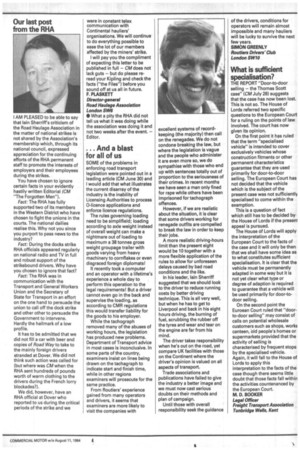. . . And a blast for all of us
Page 25

If you've noticed an error in this article please click here to report it so we can fix it.
SOME of the problems in enforcing road transport legislation were pointed out in a leading article (CM June 30) and I would add that what illustrates the current disarray of the industry is the inability of Licensing Authorities to process 0-licence applications and enforce licence regulations.
The rules governing loading need to be sirnplifield; loading according to axle weight instead of overall weight can make a nightmare out of loading to maximum a 38 tonnes gross weight groupage trailer with goods varying from heavy machinery to cornflakes or even disgraced foreign diplomats!
It recently took a computer and an operator with a lifetime's experience a whole day to perform this operation to the legal requirements! But a driver cannot even go in the back and supervise the loading, as according to CMR regulations this would transfer liability for the goods to his employer.
While the tachograph removed many of the abuses of working hours, the legislation has produced new problems. Department of Transport advice in most cases is inconclusive. In some parts of the country, examiners insist on lines being drawn on the tachagraph to indicate start and finish time, while in other regions examiners will prosecute for the same practice.
From Routiers' experience gained from many operators and drivers, it seems that examiners are more likely to visit the companies with excellent systems of recordkeeping (the majority) then call on the renegades. We do not condone breaking the law, but where the legislation is vague and the people who administer it are even more so, we do sympathise with those who end up with sentences totally out of proportion to the seriousness of their crimes. In recent months we have seen a man only fined for rape while others have been imprisoned for tachograph offences.
However, if we are realistic about the situation, it is clear that some drivers working for renegade outfits are compelled to break the law in order to keep their jobs.
A more realistic driving-hours limit than the present eight would be 10 together with a more flexible application of the rules to allow for unforeseen delays caused by bad road conditions and the like.
In his leader, lain Sherriff suggested that we should look to the driver to reduce running costs by better driving technique. This is all very well, but when he has to get to Liverpool and back in his eight hours driving, the burning of fuel, scrubbing the rubber off the tyres and wear and tear on the engine are far from his mind.
The driver takes responsibility when he's out on the road, yet compare UK facilities with those on the Continent where the driver's opinion is valued on all aspects of transport.
Trade associations and publications have failed to give the industry a better image and we must now cast serious doubts on their methods and plan of campaign.
Until those with overall responsibility seek the guidance of the drivers, conditions for operators will remain almost impossible and many hauliers will be lucky to survive the next few years.
SIMON GREENLY Routiers Drivers Club London SW10




















































































